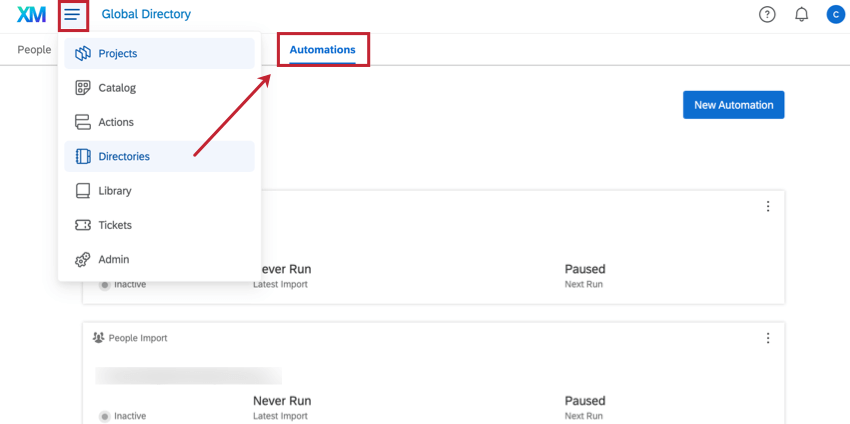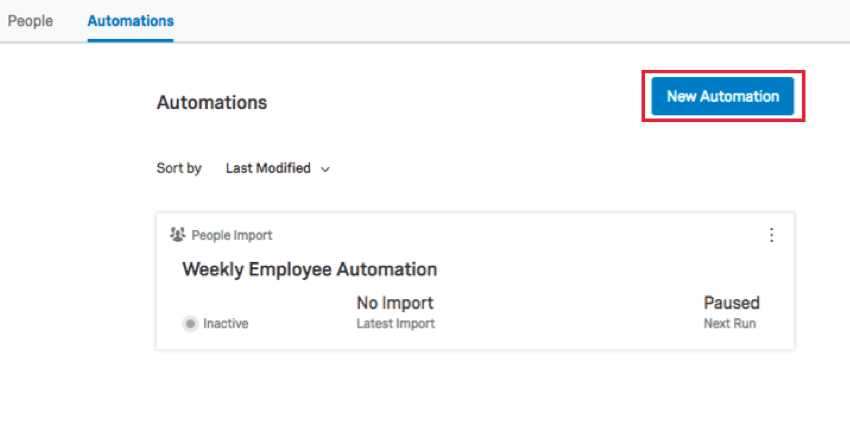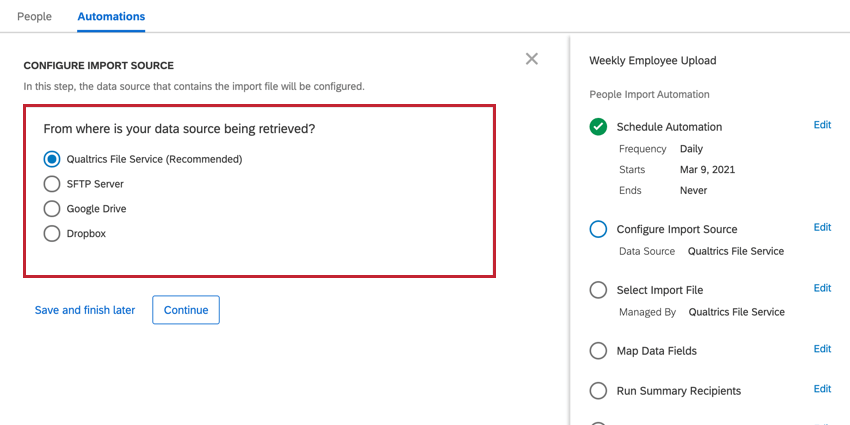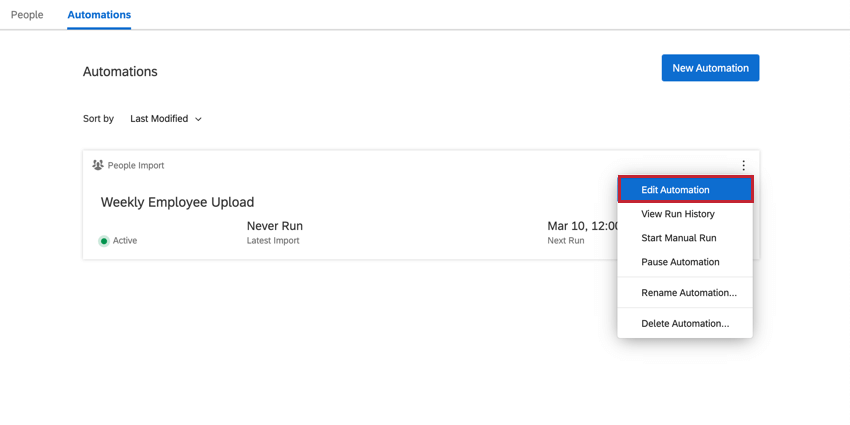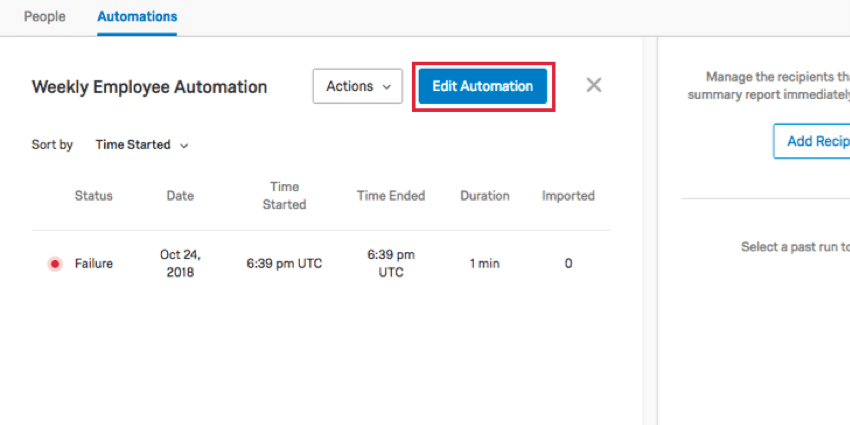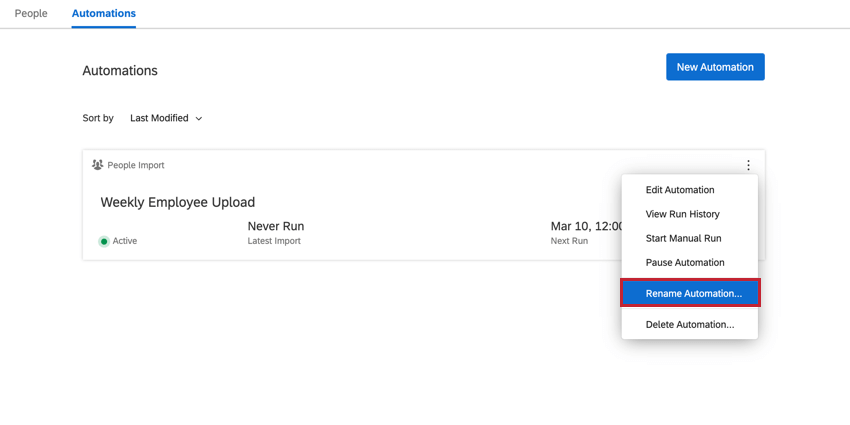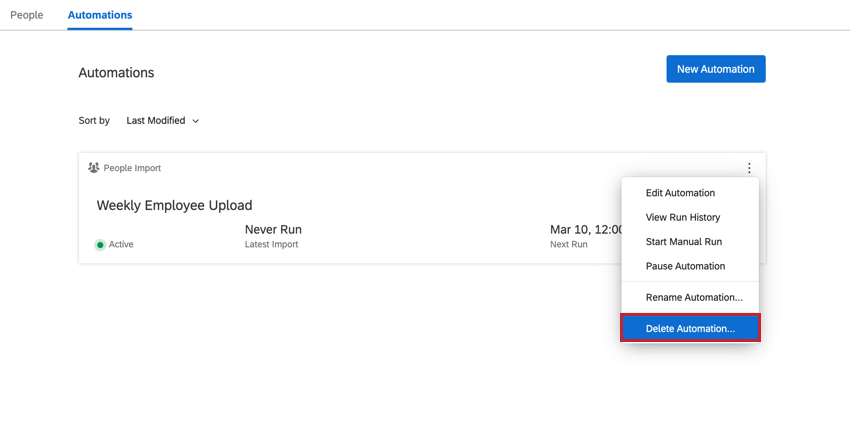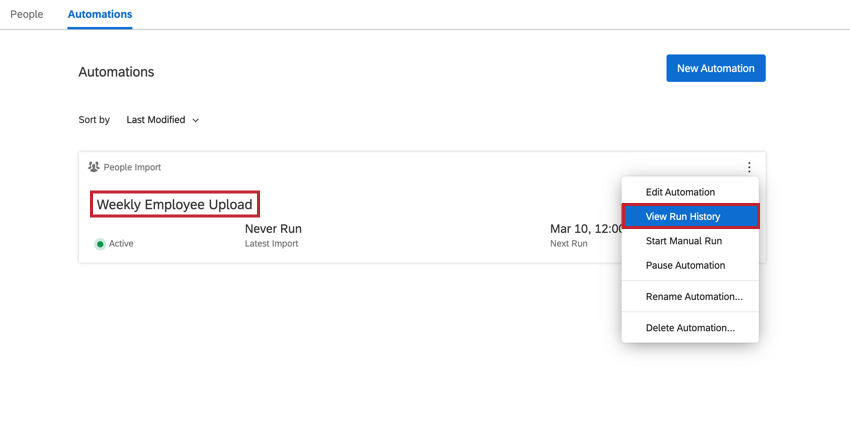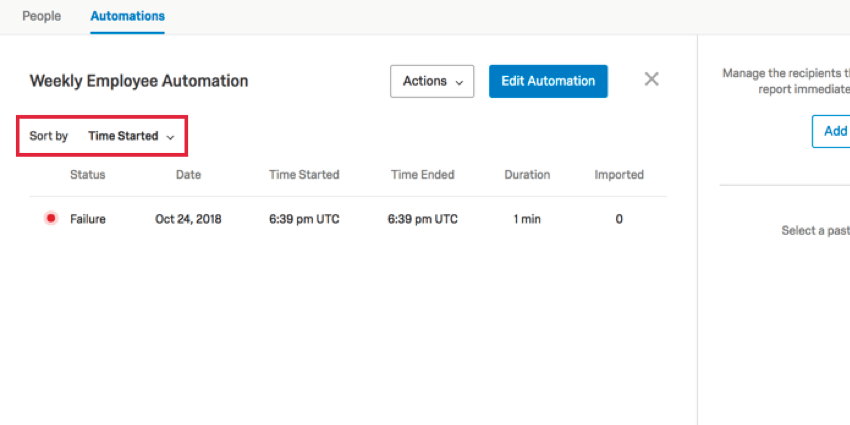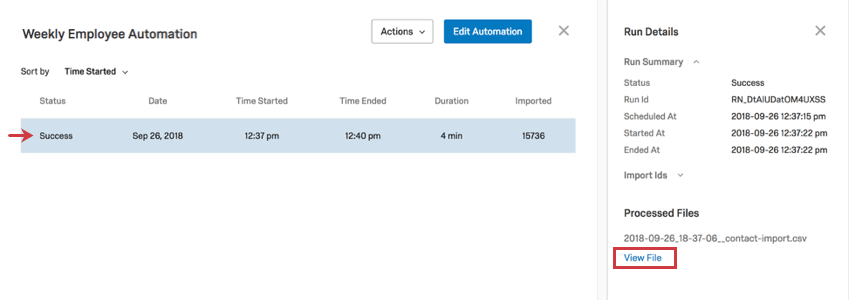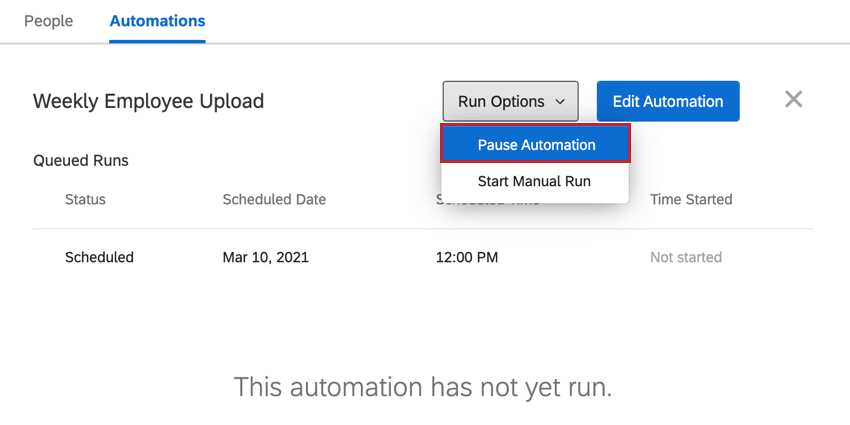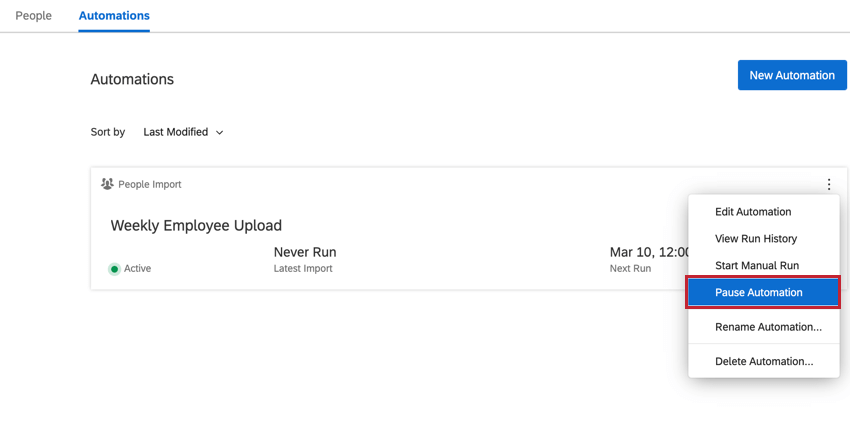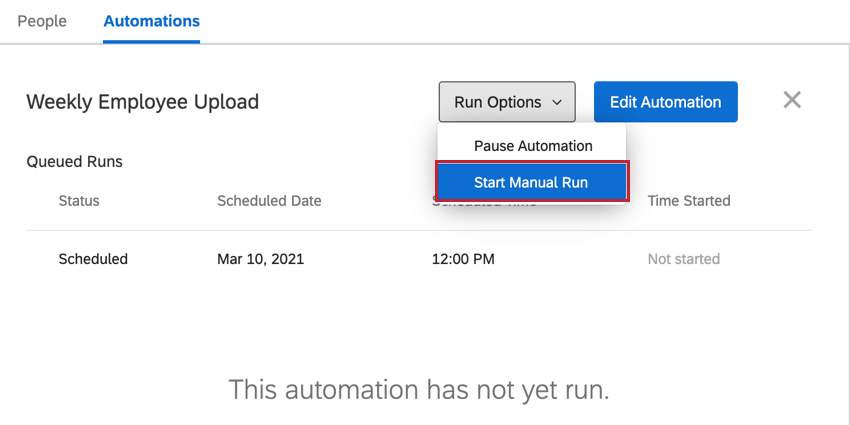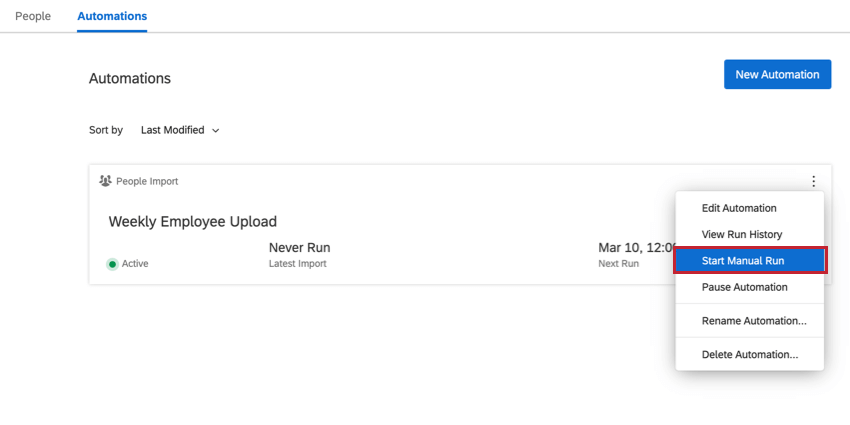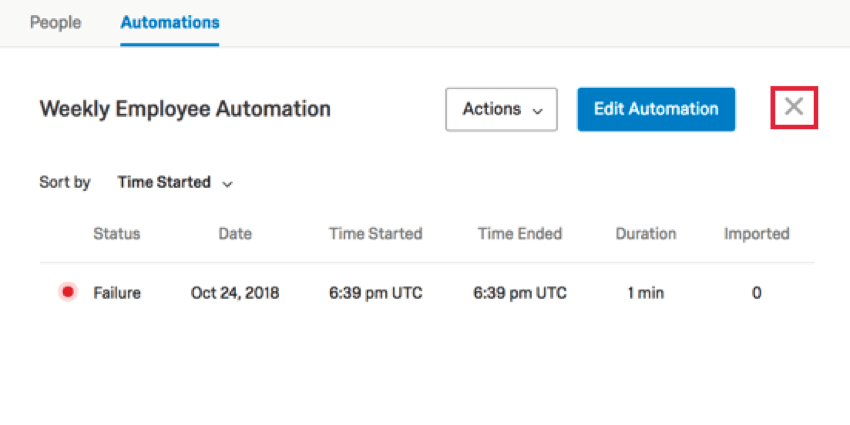Employee Directory Import Automations (EX)
About Employee Directory Import Automations
Users often wish to sync their employee (HRIS) records with Qualtrics using automations that bring that data into Qualtrics on a regular schedule. For example, you may wish to import content from a hosted daily file drop, all under the most safe and secure transfer methods.
With people import automations (also called Employee Directory import automations), you can create, configure, update, test, and review your own automation jobs, which streamlines your uploads to the employee directory. When the automation is scheduled to run, it’ll process any designated files that have not been processed by the automation yet, including newly uploaded files.
You can set these up in the Automations tab of your Employee Directory.
Step 1: Starting and Scheduling the Automation
- Name your automation.
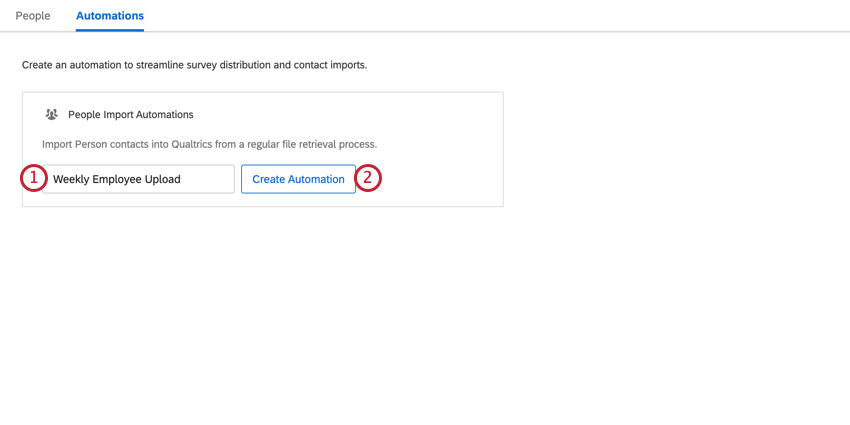
- Click Create Automation.
- Determine whether your automation should happen daily, weekly, monthly, or On-Demand. (In other words, choose when your employee files will be checked for updates and then uploaded to Qualtrics.) If you select On-Demand, the automation will check files every 15 minutes and process those eligible.
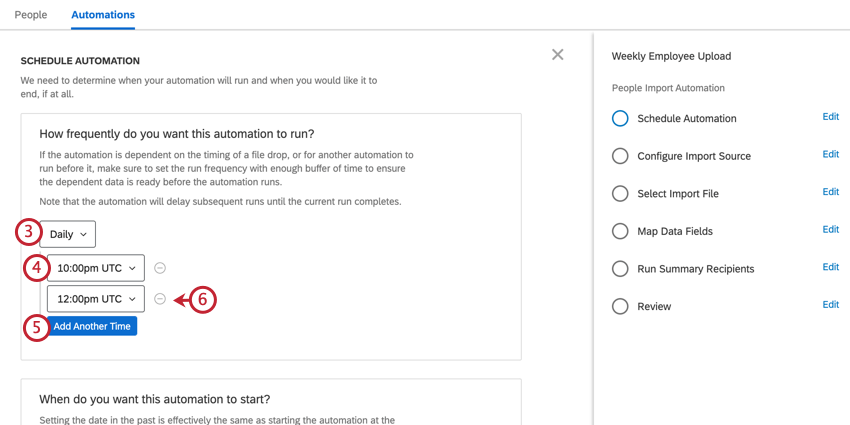
- Determine the time of day / day of the week it should take place. You can run on the hour, or 15, 30, or 45 minutes after the hour.
- Click Add Another Time to add another time of day / week / month this update should occur.
Qtip: There is a limit of 8 times daily, 10 times weekly, or 6 times monthly. While you can technically add the same time multiple times, this will result in the automation only being run once on that time.
- Use the minus sign (–) to remove times.
- Determine the date you want the first automation to take place.
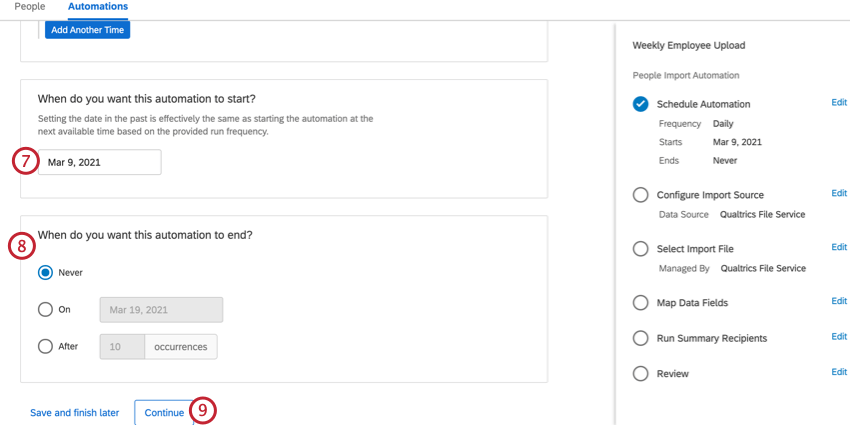 Qtip: If the date is set to today or in the past, the automation will run from now on.
Qtip: If the date is set to today or in the past, the automation will run from now on. - Determine when you want the automation to stop importing contacts. You can always modify this later.
- Click Continue to enter the next step, Configuring an Import Source.
Step 2: Configuring an Import Source
When you reach Configure Import Source in the people import automation, you tell Qualtrics the location of the employee data you would like to import. You have a few options.
- Qualtrics File Service: Set up a file service with Qualtrics. This eliminates the task of setting up an SFTP server on your own side. When you select this option, you’ll be shown instructions on how to set this up.
- SFTP Server (Password or SSH Key): You have your own server where these files will be hosted. You must provide the username, password, host URL and port of the SFTP server for the automation to import the files. Alternatively, you can set up by providing the SSH key.
Qtip: When setting up an SFTP connection, we recommend your IT team Allowlist the Qualtrics IP Ranges. See Allowlist Qualtrics Servers.
Qtip: If your account is within our FedRAMP environment, the IP addresses for allowlisting differ from those found on this page. To securely access your IP address information, please login to your FedRAMP Customer Success Hub. - Google Drive or Dropbox: You have access to an Open Authorization (OAuth) file storage, such as Google Drive or Dropbox, where your import files will be hosted. You must login and give Qualtrics permission to manage your files on the OAuth file storage. The automation will only manage the files in a designated folder configured in the next step.
Step 3: PGP Encryption
PGP encryption is an optional step for people import automations to encrypt the data you send to Qualtrics. See PGP Encryption for more information about this feature.
- Select whether you’d like the file to be encrypted using PGP software.
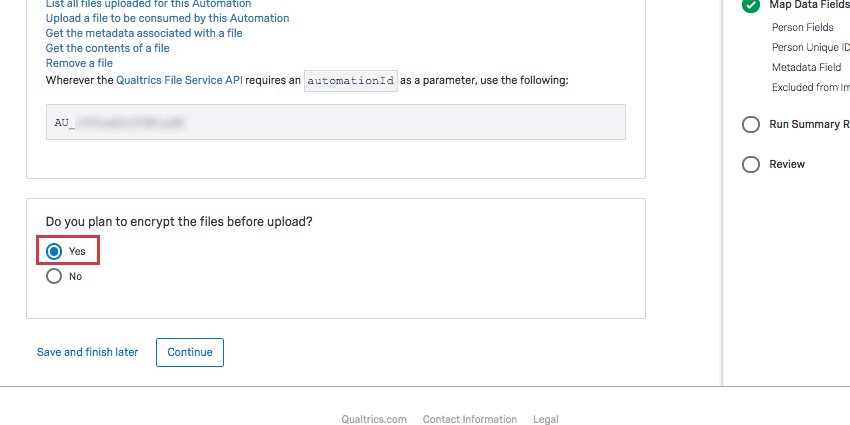 Qtip: This PGP encryption is available for automations using both SFTP servers and the Qualtrics File Service. If you did not encrypt a past automation but would like to, you can always edit the automation to add encryption.
Qtip: This PGP encryption is available for automations using both SFTP servers and the Qualtrics File Service. If you did not encrypt a past automation but would like to, you can always edit the automation to add encryption. - Click Continue.
- Click Download our public key. Your IT team will need to use that public key to encrypt import files before uploading them to the SFTP server or the Qualtrics File Service.
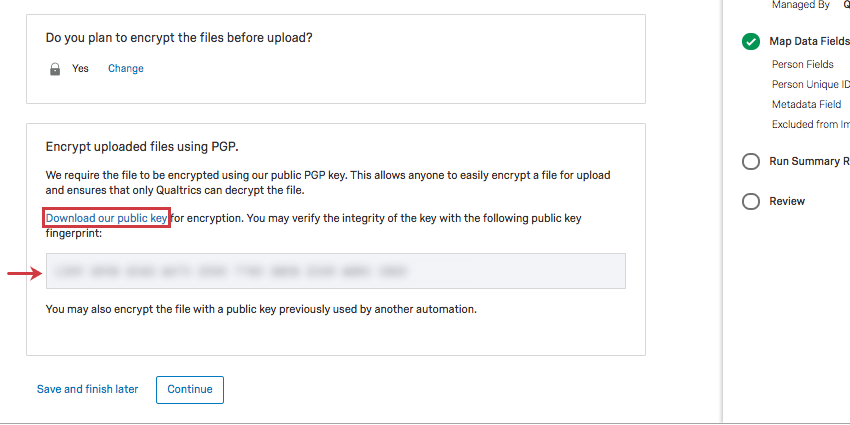 Qtip: If an automation is configured to use PGP encryption but receives an unencrypted file, it will fail and notify the email recipients, as per the notification preferences in the automation.
Qtip: If an automation is configured to use PGP encryption but receives an unencrypted file, it will fail and notify the email recipients, as per the notification preferences in the automation. - Click Continue.
- Now you will either define your SFTP folder paths, or go straight to data field mapping.
Step 4: Selecting Folder Paths
After you decide the source of your employee files, you need to specify the folders where these files are saved so the automation knows where to retrieve them from.
- Enter the name of the folder on the SFTP server, Google Drive, or Dropbox the file you want to import is located on.
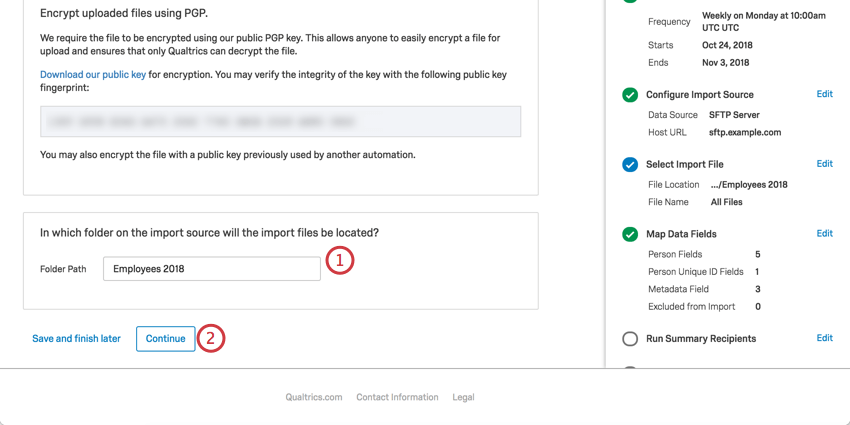 Qtip: This folder name is case sensitive. This must be an existing folder, or the automation will fail. The folder path should also be relative to the default directory of the SFTP, Google Drive, or Dropbox user provided to the automation.
Qtip: This folder name is case sensitive. This must be an existing folder, or the automation will fail. The folder path should also be relative to the default directory of the SFTP, Google Drive, or Dropbox user provided to the automation. - Click Continue.
- Select which files should be imported from this folder.
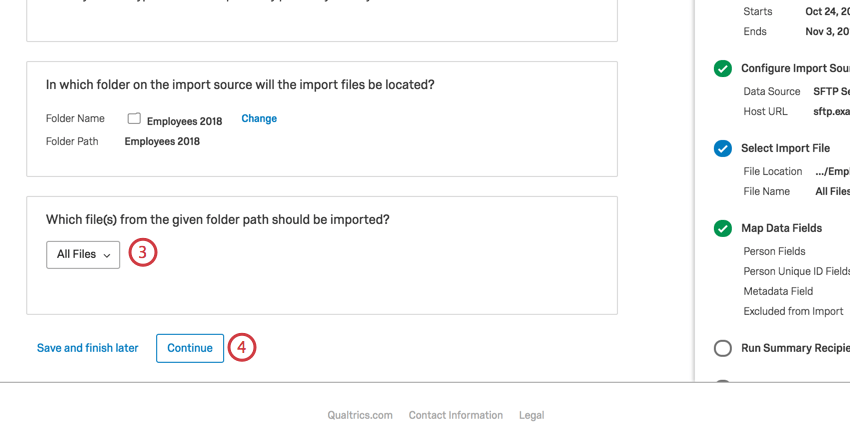 Your options are:
Your options are:
- All Files: All files in the folder.
- Files whose name contain a specific prefix: When selected, you can specify the prefix.
- Files whose name contain a specific suffix: When selected, you can specify the suffix. The file extension is included here.
Example: The file name is 1234-sample and it as a CSV. You want all files that end with -sample and are CSVs. Your suffix would be -sample.csv
- Files whose name contains specific text: When selected, you can specify the phrase the names must contain. This phrase can be anywhere in the file name.
- Click Continue.
- Processed file will be stored on Qualtrics and can be viewed when managing past automations. Click Continue.
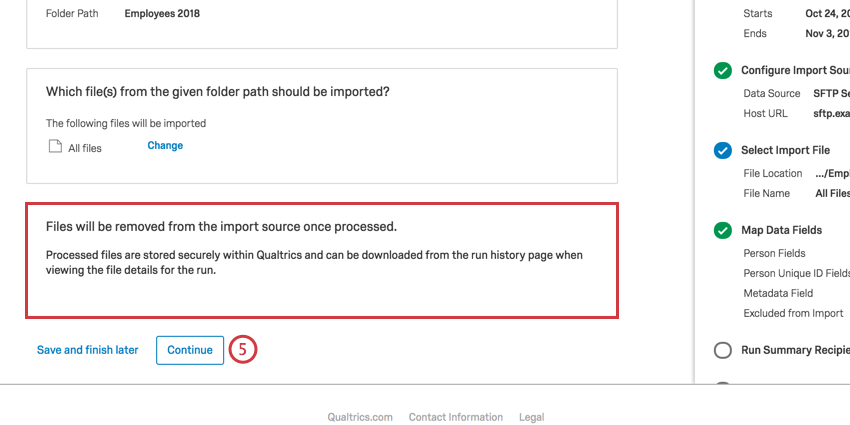
Step 5: Data Field Mapping
This is where you decide what fields will be imported into Qualtrics from your files and how they are formatted.
Attention: You must include a First Name, Last Name, UniqueID, and Email column. These should correspond to the following field types:
- First Name – Person Field
- Last Name – Person Field
- Email – Person Field
- UniqueID – Person Unique ID Field
- Click Download Example File. This will download a CSV to your computer that provides an example of a correct file template. You may also use your own template file, as long as it is a valid CSV file. All files imported by this automation will need to match the example file column headers.
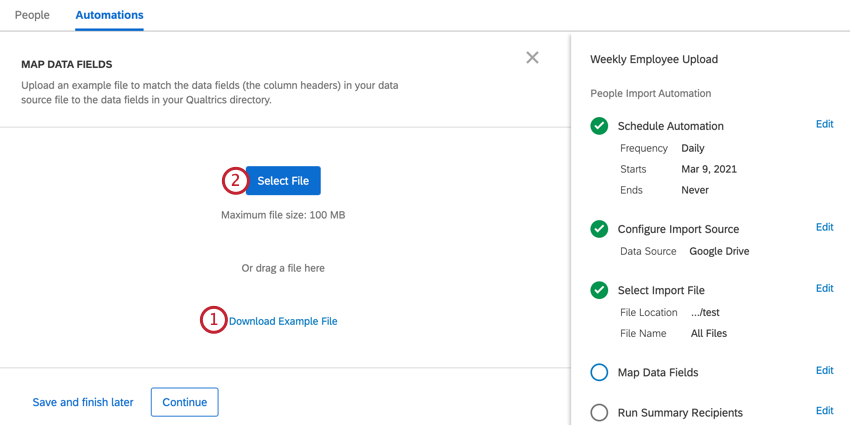
- When your file is ready, click Select File and upload your example file.
Qtip: Example files cannot exceed 100MB for each automation.
- Choose a Delimiter.
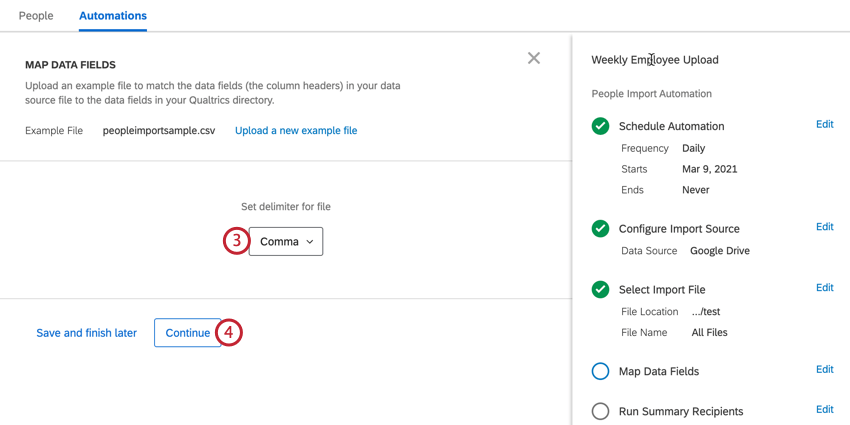
- Click Continue.
- Suggested column headers for Qualtrics field mappings will be provided; however, you can rename any column or map a column to an existing Metadata field by modifying the dropdowns in the Import as Field Name row. Note that if you’re naming a column after a Metadata Data field, it should generally be case-sensitive.
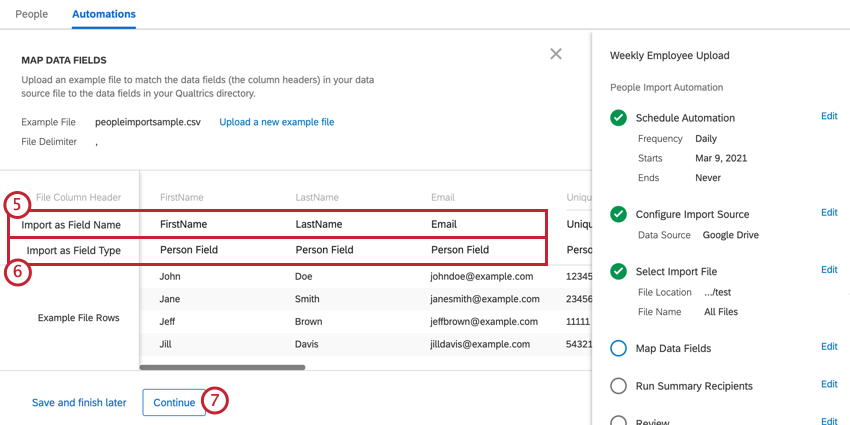
- Use the Import as Field Type row to determine if each field is a Person Field (Email, first name, last name), Person UniqueID Field, Metadata Field, or if it should be excluded from the import.
Qtip: Suggested column headers to Qualtrics field mappings will be provided. You can rename any column or map a column to an existing Metadata field by modifying the dropdowns in the Import as Field Type row. Note that if you’re naming a column after a Metadata field, it must be case-sensitive.
Qtip: If you’d like to replace the file you uploaded, click Upload a new example file. - Once you’ve reviewed your fields, click Continue.
Step 6: Sending Run Reports and Enabling the Automation
The final steps of a people import automation include determining who is emailed when an automation runs, and then enabling the automation. This encompasses the Run Summary Recipients and Review portions of the automation.
- Determine who will be alerted with an email when the automation runs by entering their email address in the box.
- Use the plus signs ( + ) or the Add Recipient Email button to add additional recipients. Use the minus sign ( – ) to remove recipients.
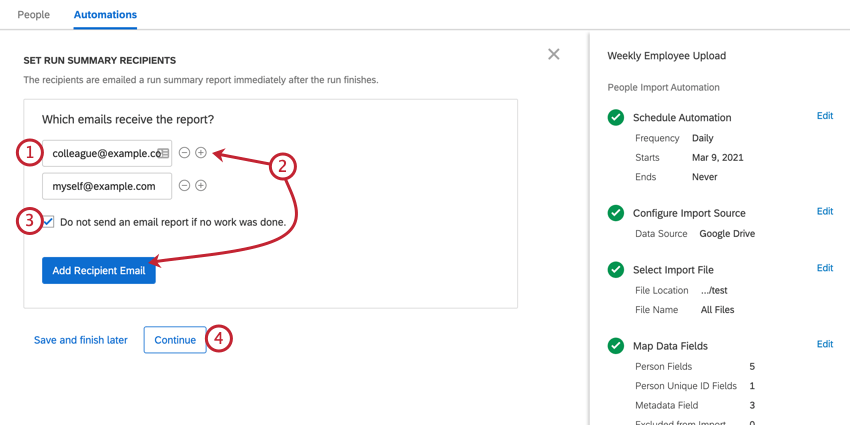
- If desired, check the Do not send an email report if no work was done. This will prevent the report from sending if no employees in your directory were updated.
- Click Continue.
- Click Edit next to go back to any section and make changes.
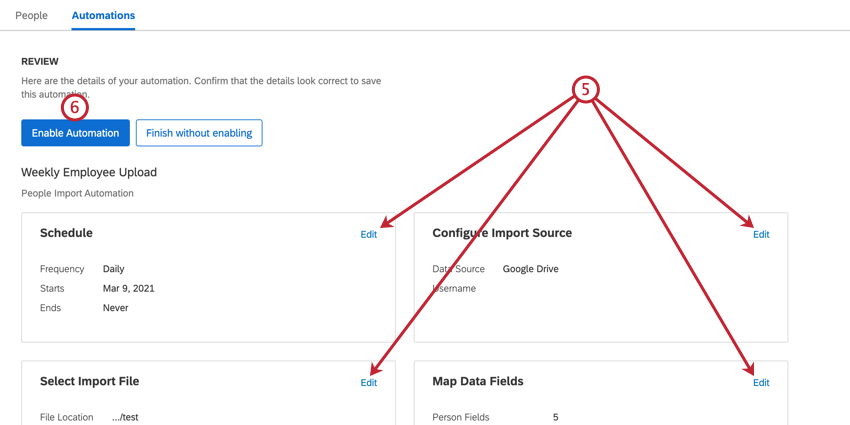
- Click Enable Automation to start your automation, or click Finish without enabling to save the automation but not start it.
Changing Data Fields Included in the Automation
There may be times that you want to modify the fields included in the people import automation. For example, maybe you realized you forgot to include a patient address column in your people imports, and now you want to save patient address information in future people imports.
The example file that you upload in the Map Import Fields section determines the metadata fields that will be uploaded to Qualtrics. This means you can exclude column headers to skip over them, or you can use the exact name and spelling of a field to include it in future imports.
To change the fields included in an import:
- Go to the desired automation and click the dropdown.
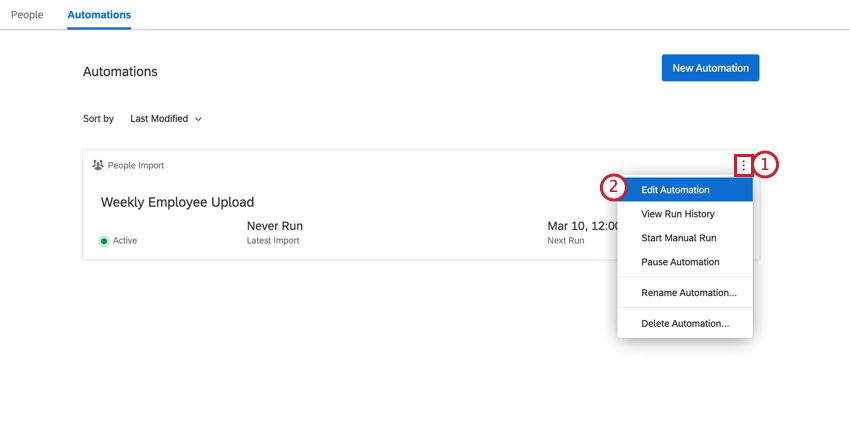
- Click Edit Automation.
- Click edit next to where it says Map Data Fields.
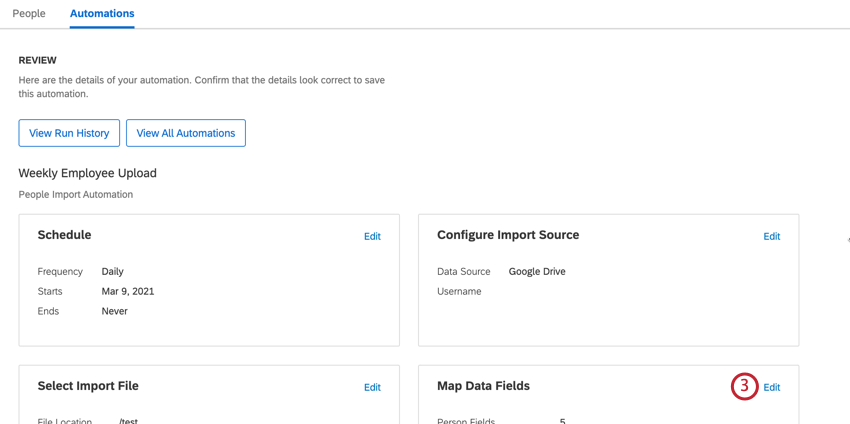
- Click Upload a new example file.
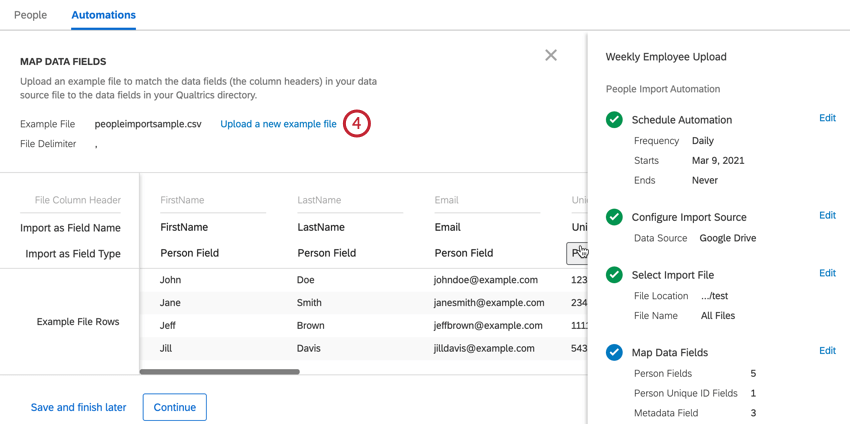
- Click Download Example File.
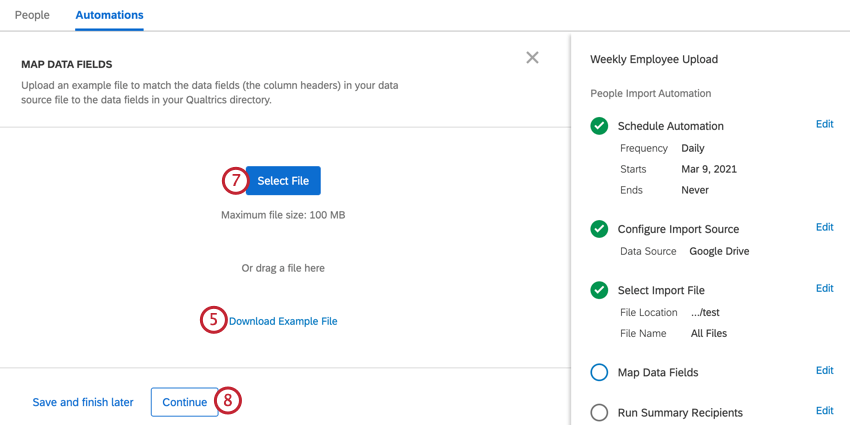
- Edit the file so it includes your desired headers. Make sure spelling and capitalization is the same.
Example: The files you keep in your source folder have a field called Address. In the Example File, add a header called Address. Using a lowercase ‘a’ will not work.
- Click Select File. Upload your new file.
- Click Continue.
- Suggested column headers for Qualtrics field mappings will be provided; however, you can rename any column or map a column to an existing Metadata field by modifying the dropdowns in the Import as Field Name row. Note that if you’re naming a column after an existing Metadata field, it should generally be case-sensitive.
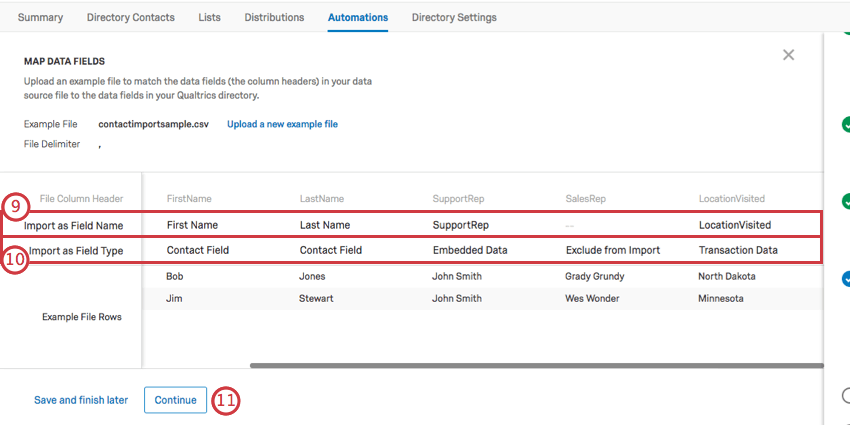
- Use the Import as Field Type row to determine if each field is a Person Field, UniqueID, Metadata, or if it should be excluded from import.
- Once you’ve reviewed your fields, click Continue.
Creating Additional Automations
Once you have created automations, you can add more by clicking New Automation in the upper-right.
Edit Existing Automations
You can change the setup of any of your automations by clicking the dropdown and selecting Edit Automation.
Qtip: You can also do this by clicking into the automation and clicking the blue Edit Automation button.
Clicking Edit Automation will take you back to a page where you can change the different steps of the automation, such as the referenced servers, folders, and so on.
Rename Automation
By clicking the dropdown and selecting Rename Automation, you can rename your automation.
Delete Automation
By clicking the dropdown and selecting Delete Automation, you can delete your automation.
Managing Automation Schedules & Notifications
In order to view when the automation has run in the past, you can either click its name or the dropdown and then View Run History.
Past Automations
Once automations have been attempted, they will be listed here with information about the time they began and ended, how many employees were imported, the duration, and the status.
The status can either be Success or Failure. Failures are generally due to incorrect settings, such as the wrong SFTP server being referenced, incorrect username and password, and so on.
You can change the order of your past automations using the Sort by dropdown on the upper-left.
Processed Files
When you click on an automation conducted in the past, you can click View File to see the files that were imported during this automation.
Pause/Resume Automation
You can Pause or Resume an automation by clicking Run Options inside the automation, or by clicking the dropdown next to an automation.
Pause Automation allows you to temporarily pause the automation. You can then resume the automation whenever you desire by selecting Resume Automation.
Manual Runs
You can run an additional automation outside the current schedule by performing a manual run. You can start a manual run by clicking Run Options inside the automation, or by clicking the dropdown next to an automation.
Return to Automations
Click the X in the upper-right to return to the main page of the Automations tab.
